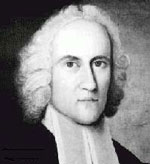Издателство |
| :. Издателство
LiterNet |
Медии |
| :. Електронно списание LiterNet |
| :. Електронно списание БЕЛ |
| :. Културни
новини |
Каталози |
| :. По
дати : Март |
| :. Електронни книги |
| :. Раздели / Рубрики |
| :. Автори |
| :. Критика за авторите |
Книжарници |
| :. Книжен
пазар |
| :. Книгосвят: сравни цени |
Ресурси |
| :. Каталог за култура |
| :. Артзона |
| :. Писмена реч |
За
нас |
| :. Всичко за LiterNet |
JONATHAN EDWARDS
(1703-1758)
 Jonathan
Edwards, third president of Princeton for a brief period in 1758, was born in
East Windsor, Connecticut, where his father was pastor. The only son in a family
of eleven children, he entered Yale when he was not yet thirteen and graduated
four years later at the head of his class. He studied theology, preached in
a Presbyterian pulpit in New York, and in 1724 returned to Yale as tutor for
two years, the second year as senior tutor and virtual head of the college,
the rectorship then being vacant.
Jonathan
Edwards, third president of Princeton for a brief period in 1758, was born in
East Windsor, Connecticut, where his father was pastor. The only son in a family
of eleven children, he entered Yale when he was not yet thirteen and graduated
four years later at the head of his class. He studied theology, preached in
a Presbyterian pulpit in New York, and in 1724 returned to Yale as tutor for
two years, the second year as senior tutor and virtual head of the college,
the rectorship then being vacant.
In 1728 he succeeded his maternal grandfather as pastor at Northampton, Massachusetts, where his preaching brought remarkable religious revivals. But he alienated many of his congregation in 1748 by his proposal to depart from his grandfather's policy of encouraging all baptized persons to partake of Communion and instead to admit to this sacrament only those who gave satisfactory evidence of being truly converted. He was dismissed in 1750.
He moved to Stockbridge, Massachusetts, then a frontier settlement, where he ministered to a tiny congregation and served as missionary to the Housatonic Indians. There, having more time for study and writing, he completed his celebrated work, The Freedom of the Will.
Edwards was elected president of Princeton September 29, 1757, five days after the death of his son-in-law, Aaron Burr, Sr., second president of the College. He was a popular choice, for he had been a friend of the College since its inception and was the most eminent American philosopher-theologian of his time. But Edwards shrank from taking on "such a new and great business in the decline of life," feeling himself deficient in health, in temperament, and in some branches of learning. He finally yielded when a group of ministers persuaded him that it was his duty to accept. Late in January 1758, he came to Princeton, where he preached in the College chapel and gave out questions in divinity to the senior class for each to study and write "what he thought proper" before coming together to discuss them -- an eighteenth-century seminar. The seniors spoke enthusiastically of the "light and instruction which Edwards communicated."
On March 22, 1758, he died of fever following inoculation for smallpox, and was buried in the President's Lot in the Princeton cemetery beside his son-in-law, Aaron Burr.
Edwards had three sons and eight daughters. The three sons were graduated from Princeton; one of them, Jonathan Edwards, Jr. 1765, became president of Union College. Three daughters married Yale graduates; one was Burr; another was Timothy Dwight, forebear of three Yale presidents.
In 1860 Edwards' great-grandsons had a copy made of Yale's eighteenth-century portrait of him and presented it to Princeton; it hangs in the Faculty Room in Nassau Hall.
=============================
© E-publisher LiterNet, 24.12.2008
The Sun Is but a Morning Star. Anthology of American Literature. Edited by Albena
Bakratcheva. Varna: LiterNet, 2008-2010.
